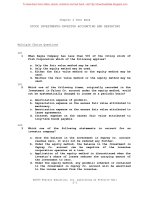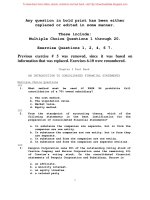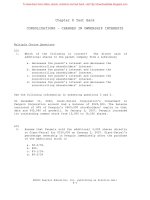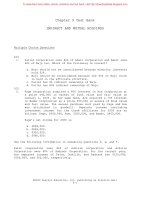Test bank strategic staffing 2e by philips gully chapter 05
Bạn đang xem bản rút gọn của tài liệu. Xem và tải ngay bản đầy đủ của tài liệu tại đây (135.96 KB, 13 trang )
Strategic Staffing, 2e (Phillips/Gully)
Chapter 5 Forecasting and Planning
1) Forecasting is not an exact science, and it is rare for a forecast to be exactly right. Given this
uncertainty, it is usually best to use the previous period's data and add/reduce some percentage
value based on managerial intuition.
Answer: FALSE
Diff: 1
Page Ref: 116-117
Skill: Concept
Objective: 1
2) A retail store that forecasts a greater need for salespeople during Thanksgiving. This is an
example of a seasonal forecast.
Answer: TRUE
Diff: 1
Page Ref: 118
Skill: Concept
Objective: 1
3) If new competitors enter an industry, customers will have greater product choices, which will
tend to dilute the demand for any one company's products or services.
Answer: TRUE
Diff: 1
Page Ref: 118
Skill: Concept
Objective: 2
4) A ratio analysis assumes that the ratio between the number of employees needed and certain
business metrics is highly variable.
Answer: FALSE
Diff: 1
Page Ref: 120
Skill: Concept
Objective: 3
5) Forecasting labor demand in small- and medium-size organizations is significantly easier
compared to large organizations because there is a stronger correlation between employee count
and productivity.
Answer: FALSE
Diff: 2
Page Ref: 120
Skill: Concept
Objective: 3
6) Scatter plots show graphically how two different variables are related.
Answer: TRUE
Diff: 1
Page Ref: 120
Skill: Concept
Objective: 3
1
Copyright © 2012 Pearson Education, Inc. Publishing as Prentice Hall
7) Bottom-up judgmental forecasting uses the input of lower-level managers to estimate the
firm's total staffing requirements.
Answer: TRUE
Diff: 1
Page Ref: 122
Skill: Concept
Objective: 3
8) Transition analysis is a qualitative technique.
Answer: FALSE
Diff: 1
Page Ref: 124
Skill: Concept
Objective: 4
9) A transition analysis can account for multiple moves.
Answer: FALSE
Diff: 2
Page Ref: 126
Skill: Concept
Objective: 4
10) Talent inventories are detailed records or databases that summarize each employee's skills,
competencies, education, training, previous performance reviews, and chances of being
promoted.
Answer: TRUE
Diff: 1
Page Ref: 126
Skill: Concept
Objective: 4
11) For a specific organization, the turnover rate is a constant.
Answer: FALSE
Diff: 1
Page Ref: 127
Skill: Concept
Objective: 4
12) The most comprehensive source of free data on conditions in the U.S. labor market is the
U.S. Bureau of Labor Statistics (BLS).
Answer: TRUE
Diff: 1
Page Ref: 128
Skill: Concept
Objective: 4
13) Business process outsourcing is the relocation of an entire business function, such as
production, manufacturing, or customer service, to an independent service provider in the same
or a different country.
Answer: TRUE
Diff: 1
Page Ref: 130
Skill: Concept
Objective: 5
2
Copyright © 2012 Pearson Education, Inc. Publishing as Prentice Hall
14) Early retirement programs are a common way of dealing with temporary employee surpluses.
Answer: FALSE
Diff: 2
Page Ref: 131
Skill: Concept
Objective: 5
15) If 4 out of 5 job offers are typically accepted, a company will have to make 120 offers so as
to hire 80 employees.
Answer: FALSE
Diff: 1
Page Ref: 132
Skill: Application
Objective: 6
AACSB: Analytic skills
16) If the proportion of high-potential applicants increases, the total number of applicants needed
to generate the right number of the right quality of new hires decreases.
Answer: TRUE
Diff: 1
Page Ref: 133
Skill: Concept
Objective: 6
17) Higher staffing efficiency percentages reflect greater staffing efficiency.
Answer: FALSE
Diff: 2
Page Ref: 134
Skill: Concept
Objective: 6
18) Which of the following is the first step in the typical workforce planning process?
A) identifying the firm's business strategy
B) articulating the firm's strategic staffing decisions
C) developing and implementing action plans
D) conducting a workforce analysis
Answer: A
Diff: 1
Page Ref: 116
Skill: Concept
Objective: 1
3
Copyright © 2012 Pearson Education, Inc. Publishing as Prentice Hall
19) Anna is the manager of human resources at Alcatec Inc. She is comparing the number of
employees required over the next six months versus the capabilities of her existing workforce
adjusted for attrition. She is trying to identify any gaps between the two. Which step of the
workforce planning process is discussed here?
A) monitor and revise the forecasts and action plans
B) articulate the firm's strategic staffing decisions
C) develop and implement action plans
D) conduct a workforce analysis
Answer: D
Diff: 2
Page Ref: 116
Skill: Application
Objective: 1
AACSB: Analytic skills
20) Typically, when interest rates rise,
A) businesses are willing to borrow more money.
B) consumers are willing to borrow more.
C) businesses are less likely to expand.
D) businesses make bigger capital investments.
Answer: C
Diff: 2
Page Ref: 118
Skill: Application
Objective: 2
AACSB: Analytic skills
21) A Japanese company that makes electronic watches exports 90 percent of its products to the
United States. Which of the following will happen if the dollar strengthens against the Japanese
Yen?
A) The company's watches will become less expensive in the US.
B) The purchasing power of US consumers will decline.
C) The company will have to reduce its number of employees.
D) The company will export lesser number of watches to the US.
Answer: A
Diff: 3
Page Ref: 118
Skill: Application
Objective: 2
AACSB: Analytic skills
4
Copyright © 2012 Pearson Education, Inc. Publishing as Prentice Hall
22) Which of the following events suggests that a home improvement store such as Home Depot
or Lowe's will need fewer workers in the next 1-3 years?
A) increased housing purchases
B) a decrease in consumer disposable income
C) an increase in consumer spending
D) falling interest rates
Answer: B
Diff: 2
Page Ref: 119
Skill: Application
Objective: 2
AACSB: Analytic skills
23) ROM Corporation had kept all its hiring plans on hold during the last four quarters because
the economy was in a state of recession. ROM manufactures data cards, memory chips, and LCD
monitors. The company is analyzing market trends in order to reassess its hiring strategy for the
coming year. Which of the following, if true, would most support the argument for restarting
hiring?
A) The previous recessionary had only lasted a year.
B) Though there was a decline in profits compared to the previous year, the company recently
reported the best numbers in its industry.
C) Computer manufacturers have aggressively started hiring more staff.
D) One of ROM's fiercest rivals has started laying off its employees.
Answer: C
Diff: 3
Page Ref: 119
Skill: Critical thinking
Objective: 2
AACSB: Reflective thinking skills
24) If a company employs two office assistants for every nine architects (a staffing ratio of 2:9)
and it plans to expand and hire eighteen new architects, how many new office assistants will it
need to hire?
A) 2
B) 4
C) 6
D) 8
Answer: B
Diff: 1
Page Ref: 120
Skill: Application
Objective: 3
AACSB: Analytic skills
5
Copyright © 2012 Pearson Education, Inc. Publishing as Prentice Hall
25) Which of the following, if true, would require a company to make adjustments to its
historical employee-productivity ratios?
A) The company is able to recruit more easily because of higher unemployment in the market.
B) The company's cost of borrowing is going down.
C) The company is expecting higher volumes of work in the next two years.
D) The company is adopting a more efficient manufacturing system.
Answer: D
Diff: 3
Page Ref: 120
Skill: Critical thinking
Objective: 3
AACSB: Reflective thinking skills
26) ________ involves looking at past employment patterns and using those patterns to predict a
firm's future labor needs.
A) Trend analysis
B) Judgmental forecasting
C) ROI analysis
D) Transition analysis
Answer: A
Diff: 1
Page Ref: 121
Skill: Concept
Objective: 3
27) Which of the following forecasting methods relies on the experience and insights of people
in the organization to predict a firm's future employment needs?
A) trend analysis
B) ROI analysis
C) judgmental forecasting
D) transition analysis
Answer: C
Diff: 1
Page Ref: 122
Skill: Concept
Objective: 3
28) If managers are asked to estimate their optimal headcount for the following year for staffing
planning purposes, which of the following has been used?
A) ratio analysis
B) trend analysis
C) scatter plots
D) judgmental forecasting
Answer: D
Diff: 2
Page Ref: 122
Skill: Application
Objective: 3
AACSB: Analytic skills
6
Copyright © 2012 Pearson Education, Inc. Publishing as Prentice Hall
29) Why is it usually best to supplement the ratio, scatter plot, and trend forecasting methods
with managerial judgment?
A) because judgment forecasting is the most accurate method
B) because historical trends and relationships can change
C) because top-down approaches need analytical validation
D) because firms need to keep their fingers on the pulse of their labor markets
Answer: B
Diff: 2
Page Ref: 122
Skill: Concept
Objective: 3
30) New salespeople at a retail store generate an average of $50,000 in profit their first year. In
addition, the reduced workload on the rest of the sales staff improves their efficiency and ability
to provide high-quality customer service by 10 percent. This is worth an additional $20,000 to
the company. The cost of hiring and training a new salesperson are expected to be $3,000 and
$8,000 respectively. The salary for this position is $35,000. What is the return on investment of
hiring an additional salesperson?
A) 152%
B) 163%
C) 200%
D) 143%
Answer: A
Diff: 3
Page Ref: 123
Skill: Application
Objective: 3
AACSB: Analytic skills
31) ________ is a quantitative technique that can be used to analyze a firm's internal labor
markets and forecast its internal labor supply.
A) Trend analysis
B) Judgmental forecasting
C) ROI analysis
D) Transition analysis
Answer: D
Diff: 1
Page Ref: 124
Skill: Concept
Objective: 4
32) Which of the following is true of transition analysis?
A) It can account for multiple moves.
B) It assumes that all employees in a job have an equal probability of movement.
C) It is a qualitative technique.
D) It does not rely on historical patterns and activity levels.
Answer: B
Diff: 2
Page Ref: 126
Skill: Concept
Objective: 4
7
Copyright © 2012 Pearson Education, Inc. Publishing as Prentice Hall
33) Identify the primary limitation of all forecasting techniques.
A) They are qualitative in nature.
B) They tend to give biased estimates.
C) They rely on managerial intuition and judgment.
D) They rely on historical patterns and activity levels.
Answer: D
Diff: 2
Page Ref: 126
Skill: Concept
Objective: 4
34) Which of the following is more likely to warrant changes in an organization's compensation
policy to offer above-market wages?
A) decreasing unemployment rates
B) decrease in the number of employees quitting jobs
C) reduction in the number of companies in its industry
D) restructuring of jobs to make them more process oriented
Answer: A
Diff: 3
Page Ref: 126
Skill: Critical thinking
Objective: 4
AACSB: Reflective thinking skills
35) Which of the following are detailed records or databases that summarize each employee's
skills, competencies, education, training, languages spoken, and chances of being promoted?
A) performance reviews
B) transition databases
C) talent inventories
D) replacement charts
Answer: C
Diff: 1
Page Ref: 126
Skill: Concept
Objective: 4
36) Which of the following would be most useful for a firm needing to quickly reassign
employees to an important new project?
A) job analysis
B) transition analysis
C) a talent inventory
D) trend analysis
Answer: C
Diff: 2
Page Ref: 126-127
Skill: Application
Objective: 4
AACSB: Analytic skills
8
Copyright © 2012 Pearson Education, Inc. Publishing as Prentice Hall
37) Which of the following visually shows each of the possible successors for a job and
summarizes their strengths, present performance, promotion readiness, and development needs?
A) scatter diagrams
B) perceptual maps
C) talent inventories
D) replacement charts
Answer: D
Diff: 1 Page Ref: 127
Skill: Concept
Objective: 4
38) After the gaps between the firm's labor supply and labor demand are identified, a firm
should:
A) develop and implement action plans.
B) conduct a workforce analysis.
C) identify its business strategy.
D) articulate its talent philosophy and strategic staffing decisions.
Answer: A
Diff: 1
Page Ref: 116
Skill: Concept
Objective: 5
39) Which of the following is a way in which many organizations try to reduce their need for
skills that will be in short supply for a number of years?
A) exiting certain lines of business
B) redesigning jobs
C) focusing on other areas where there is adequate labor supply
D) focus on unskilled labor
Answer: B
Diff: 1
Page Ref: 130
Skill: Concept
Objective: 5
40) Which of the following is a way in which companies usually deal with temporary employee
surpluses?
A) offering early retirement options
B) stopping filling of vacated positions
C) announcing massive layoffs
D) removing contingent workers
Answer: D
Diff: 2
Page Ref: 131
Skill: Concept
Objective: 5
9
Copyright © 2012 Pearson Education, Inc. Publishing as Prentice Hall
41) Which term refers to the proportion of applicants moving from one stage of the hiring
process to the next?
A) staffing yields
B) hiring yields
C) attrition
D) retention
Answer: A
Diff: 2
Page Ref: 132
Skill: Concept
Objective: 6
42) Hiring yield refers to:
A) the proportion of hires coming through a particular recruiter.
B) the return on investment from one additional hire.
C) the percent of applicants ultimately hired.
D) the proportion of applicants moving from one stage of the hiring process to the next.
Answer: C
Diff: 2
Page Ref: 132
Skill: Concept
Objective: 6
43) ________ forecasting uses historical data on the average number of hires typically made per
recruiter or the average number of recruits processed per recruiter over a given period of time,
say, a week, month, or year.
A) Staffing efficiency-drive
B) Hiring-yield driven
C) Staffing-yield driven
D) Workload-driven
Answer: D
Diff: 1
Page Ref: 134
Skill: Concept
Objective: 6
44) A firm's internal and external staffing costs were $50,000, and 5 people were hired, each
with a starting base salary of $40,000. What would be the firm's staffing efficiency?
A) 12.5%
B) 25%
C) 16.7%
D) 125%
Answer: B
Diff: 2
Page Ref: 134
Skill: Application
Objective: 6
AACSB: Analytic skills
10
Copyright © 2012 Pearson Education, Inc. Publishing as Prentice Hall
45) Which of the following observations is true?
A) Continuous recruiting involves recruiting an entirely new applicant pool every time the
organization has one or more positions to fill.
B) Batch recruiting is particularly useful for positions that turn over relatively quickly.
C) Jobs recruited using batch recruiting typically take a longer time to fill than jobs recruited
using continuous recruiting.
D) Continuous recruiting does not work well for jobs that take a long time to fill, or for jobs that
cost the organization a lot of money while they are vacant.
Answer: C
Diff: 2
Page Ref: 135
Skill: Concept
Objective: 6
46) Describe the five steps in the workforce planning process.
Answer: The five steps in the typical workforce planning process are described below.
1. Identify the business strategy. A firm's strategic vision, mission, and strategy affect current
and future staffing requirements by influencing the types and numbers of employees needed.
2. Articulate the firm's talent philosophy and strategic staffing decisions. Firms differ in their
commitment to things like promoting workers, retaining workers, and their preference for hiring
people with certain skills or training them after they are hired. Because these factors influence
the nature of the firm's future labor supply and the type of workers it will need, they are
important to understand when forecasting and planning.
3. Conduct a workforce analysis. Forecast both labor demand and labor supply, and identify any
gaps between the two.
4. Develop and implement action plans. Develop action plans to address any gaps between labor
demand and labor supply forecasts. The action plans should be consistent with the firm's talent
philosophy, and can include recruiting, retention, compensation, succession planning, and
training and development. Action plans can be short-term or long-term, depending on the firm's
needs and the predictability of the environment. Action plans to address aging workforce issues
or workforces that have a disproportionate number of similarly aged employees may need a
longer timeframe.
5. Monitor, evaluate and revise the forecasts and action plans. As the environment changes,
forecasts and action plans may need to change as well.
Diff: 2
Page Ref: 116
Skill: Concept
Objective: 1
47) How can competitor forecasts influence a firm's forecast of its own future business activity?
Answer: If new competitors enter an industry, customers will have greater product choices,
which will tend to dilute the demand for any one company's products or services. For example,
in the face of increased competition from foreign carmakers, many U.S. carmakers, including
GM and DaimlerChrysler, experienced declining demand for their products and downsized their
workforces. Alternately, if a firm leaves a market, then its surviving competitors might
experience greater demand for their products or services.
Diff: 2
Page Ref: 118
Skill: Concept
Objective: 2
11
Copyright © 2012 Pearson Education, Inc. Publishing as Prentice Hall
48) What are talent inventories and replacement charts, and how are they used in forecasting
labor supply?
Answer: Manual or computerized talent inventories summarize each employee's skills,
competencies, and qualifications. They may also contain information about the employee's
education and training, languages spoken, previous performance reviews, and chances of being
promoted. Particularly if they are computerized, qualifications inventories can be easily searched
to identify which employees might be good fits for open positions. A talent inventory can be a
powerful tool for quickly getting the right talent in the right place when it is needed.
Replacement charts are a way to track the potential replacements for particular positions. A
replacement chart can be manual or automated, and visually shows each of the possible
successors for a job and summarizes their strengths, present performance, promotion readiness,
and development needs.
Diff: 2
Page Ref: 126-127
Skill: Concept
Objective: 4
49) Discuss the different ways in which a firm can deal with temporary employee surpluses.
Answer: When a firm expects a business slowdown to be temporary, it has several options. If
slowdowns are cyclical or happen frequently, using temporary or contingent workers who are the
first to be let go when business slows can help buffer key permanent workers and provide them
greater employment security. Temporary layoffs are another option to deal with a short-term
employee surplus, but they sometimes need to last more than six months to be cost-effective due
to severance costs, greater unemployment insurance premiums the firms must pay, temporary
productivity declines in the firm's remaining workforce, and the rehiring and retraining process.
Losing the investments the organization previously made to hire and train the laid off workers
can also be costly. Alternatives to layoffs include across-the-board salary cuts or a reduction in
work hours, or reallocating workers to expanding areas of the business. Some firms offer unpaid
vacations, sabbaticals, job sharing, and other creative solutions to temporary surpluses.
Diff: 2
Page Ref: 131
Skill: Concept
Objective: 5
12
Copyright © 2012 Pearson Education, Inc. Publishing as Prentice Hall
50) Compare and contrast workload-driven forecasting and staffing efficiency-driven
forecasting.
Answer: Workload-driven forecasting uses historical data on the aver-age number of hires
typically made per recruiter or the average number of recruits processed per recruiter over a
given period of time, say, a week, month, or year. For example, if an organization's average
recruiter can process 100 applicants during a recruiting drive, the company will need a staff of 20
recruiters to process 2,000 applicants. Similar procedures can be used to estimate the amount of
additional resources the telephone costs, advertising costs, photocopying, background checks,
medical tests, and so forth needed for the staffing effort. The amount of money that needs to be
budgeted for the staffing effort depends not only on the number of people to be hired but whether
applicants are local or from far away, the recruiting sources used, the selection methods
employed, and the tightness of the labor market.
Staffing efficiency-driven forecasting is another method of forecasting how many recruiters are
needed. Staffing efficiency is the total cost associated with the compensation of the newly hired
employees that is, the total starting base pay of all new employees. For example, if a firm's
internal and external staffing costs were $100,000, and 10 people were hired, each with a starting
base salary of $60,000, the firm's staffing efficiency would be 100,000/600,000 or 16.67 percent.
Lower staffing efficiency percentages reflect greater staffing efficiency. Because the staffing
efficiency approach is financially and efficiency driven rather than workload driven, it can be a
useful metric for evaluating how well a firm's staffing plans are working. The method can also be
used to set a budget for an upcoming hiring effort.
Diff: 2
Page Ref: 134
Skill: Synthesis
Objective: 6
AACSB: Analytic skills
13
Copyright © 2012 Pearson Education, Inc. Publishing as Prentice Hall









